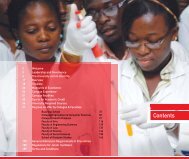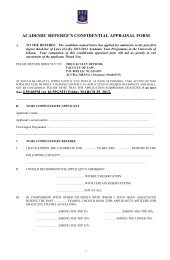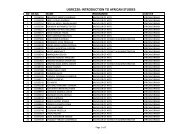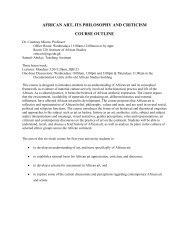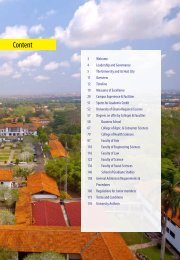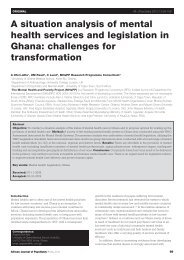Gender and Culture - Institute of African Studies - University of Ghana
Gender and Culture - Institute of African Studies - University of Ghana
Gender and Culture - Institute of African Studies - University of Ghana
Create successful ePaper yourself
Turn your PDF publications into a flip-book with our unique Google optimized e-Paper software.
<strong>Gender</strong> & <strong>Culture</strong> in <strong>African</strong><br />
Societies<br />
Duration: 6 Weeks
Course Objectives<br />
• To critically examine existing assumptions<br />
about gender <strong>and</strong> culture<br />
• To explore how gender relations are shaped by<br />
power relations <strong>and</strong> cultural practices in<br />
different socio-economic contexts<br />
• To examine how cultural forms manifest<br />
unequal power relations within society.
Learning Objectives<br />
• By the end <strong>of</strong> the session you should be able<br />
to:<br />
– Explain how culture shapes the positions <strong>of</strong><br />
women <strong>and</strong> men in <strong>African</strong> societies<br />
– Analyze cultures <strong>and</strong> cultural practices as<br />
dynamic, contested <strong>and</strong> rooted in socio-economic<br />
conditions <strong>and</strong> power relations.<br />
– Identify how key concepts in gender studies are<br />
related to debates about accepted notions <strong>of</strong><br />
culture.
Week 7: Introduction to <strong>Gender</strong> <strong>and</strong><br />
<strong>Culture</strong> in Africa<br />
• At the end <strong>of</strong> today’s class, you should be able to:<br />
– Define culture<br />
– Identify the components <strong>of</strong> culture<br />
– Myths about culture<br />
– Distinguish between tradition <strong>and</strong> culture<br />
– Establish the relationship between gender <strong>and</strong><br />
culture.<br />
– Examine culture as rooted in contemporary socioeconomic<br />
power relations.
What is culture <strong>and</strong> what are its<br />
components<br />
• Discussion: What comes to mind when you<br />
hear the word culture
Definitions <strong>of</strong> <strong>Culture</strong><br />
• Here is an <strong>of</strong>ten-used definition <strong>of</strong> culture:<br />
• "<strong>Culture</strong>, or civilization, taken in its broad,<br />
ethnographic sense, is that complex whole which<br />
includes knowledge, belief, art, morals, law,<br />
custom, <strong>and</strong> any other capabilities <strong>and</strong> habits<br />
acquired by (a person) as a member <strong>of</strong> society."<br />
(Tylor 1958 [1871]: 1<br />
• Note the links between the material aspects <strong>of</strong><br />
culture (art) <strong>and</strong> the non-material (morals, etc)<br />
• Link between definitions <strong>and</strong> key components <strong>of</strong><br />
culture
Myths about culture<br />
• First myth - <strong>Culture</strong> is static. In reality, culture<br />
changes over time in response to both internal <strong>and</strong><br />
external forces.<br />
• In terms <strong>of</strong> internal forces, as children migrate in<br />
search <strong>of</strong> work, our ideas about who should care for<br />
parents change. First, people use extended family<br />
members. When that unavailable, resort to paying<br />
non kin to do so.<br />
• In terms <strong>of</strong> external forces, telecommunications<br />
technology, colonialism, etc are good examples.
Myths about culture<br />
• Second myth: <strong>Culture</strong> is the same as tradition.<br />
• Tradition refers to a subset <strong>of</strong> the components <strong>of</strong><br />
culture, specifically beliefs, rituals that have been<br />
passed down from generation to generation.<br />
Inherent in the concept <strong>of</strong> tradition is the notion <strong>of</strong><br />
statism.<br />
• Hobsbawm <strong>and</strong> the concept <strong>of</strong> invented traditions.<br />
• <strong>Culture</strong> on the other h<strong>and</strong> is dynamic.
<strong>Gender</strong> as a cultural construction I<br />
• <strong>Culture</strong> is a dynamic construct <strong>and</strong> is socially<br />
constructed: Among the Wodaabe <strong>of</strong> the<br />
Sahel the men are the ones who apply makeup
<strong>Gender</strong> as a cultural construction I<br />
• In some parts <strong>of</strong> Africa, men carry babies on<br />
their backs, in other parts, women do
<strong>Gender</strong> as a cultural construction II<br />
• Same context, different practices over time:<br />
Cape Coast Vice-Chancellor (2011)
What accounts for different cultural<br />
constructions <strong>of</strong> gender<br />
• Biological explanations <strong>and</strong> its limits:<br />
Biological reproduction is used to justify the<br />
confinement <strong>of</strong> the woman to the home<br />
• Cultural explanations <strong>and</strong> its emphasis on<br />
power dynamics
Cultural practices that emphasize<br />
equality <strong>and</strong> inequality<br />
• Discussion <strong>of</strong> Assitan Diallo article <strong>and</strong> use the<br />
Malian case to illustrate how Malian cultural<br />
practices (nuptiality advisors who are there to<br />
ensure that since women, unlike men cannot<br />
have more than one partner, the sexual needs<br />
<strong>of</strong> women with her partner are met) enhance<br />
female sexuality <strong>and</strong> how some (female<br />
genital mutilation) constrain female sexuality
Moves around the world towards<br />
egalitarian practices<br />
• Family dynamics: House husb<strong>and</strong>s in Teshie<br />
Nungua whose partners are abroad earning a<br />
lot more money than they could make in<br />
<strong>Ghana</strong><br />
• Paternity leave (e.g. Golden Tulip two weeks<br />
Leave for new fathers, GIMPA, Third World<br />
Network, Blue Skies)<br />
• Religious institutions that allow women to<br />
lead (women ministers)
Summary <strong>of</strong> main points<br />
• <strong>Culture</strong> comprises the material (art,<br />
architecture) <strong>and</strong> non-material (norms,<br />
beliefs, customs <strong>and</strong> practices, knowledge)<br />
• <strong>Culture</strong> is dynamic<br />
• <strong>Gender</strong> is socially constructed<br />
• Cultural practices can create gender inequality<br />
• Modifications in cultural practices are now<br />
opening up spaces for gender equality
Class Exercise<br />
• Identify one cultural practice that promotes<br />
gender equality in the <strong>Ghana</strong>ian context<br />
• Identify one cultural practice that promotes<br />
gender inequality in the <strong>Ghana</strong>ian context
Closing quote for the week<br />
Sure God created man before woman. But<br />
then you always make a rough draft before<br />
the final masterpiece. ~Author Unknown
Week 8: <strong>Gender</strong> <strong>and</strong> Social<br />
Learning objectives<br />
Institutions<br />
• At the end <strong>of</strong> today’s class, you should be able<br />
to:<br />
– Identify the ways in which social institutions<br />
create, reinforce <strong>and</strong> perpetuate unequal<br />
gender relations.
The Family<br />
• Socialisation: Ways in which it creates<br />
inequality in the family context<br />
– <strong>Gender</strong> division <strong>of</strong> labour<br />
– <strong>Gender</strong> relations (behaviour expectations <strong>of</strong><br />
women <strong>and</strong> men within the family context: who<br />
should make decisions)<br />
– Bridewealth<br />
– Wife inheritance
Religion 1: Leadership in religious<br />
institutions<br />
• Old testament reference to Deborah <strong>and</strong> Esther<br />
• Men as pastors, women as congregation<br />
– For Charismatic Churches: Compare CAFM,IGCG,<br />
World Miracle, Royal House Chapel, Lighthouse<br />
Chapel (Mega Churches <strong>and</strong> membership) versus<br />
Solid Rock (Smaller Churches)<br />
• For orthodox churches point out the Catholic<br />
Church - restrictions on females as Reverend<br />
Mothers<br />
• For Islam, prohibitions on females as Imams
Religion 11: Practices that reinforce<br />
inequality<br />
• Covering <strong>of</strong> head (Muslim <strong>and</strong> some Christian<br />
denominations)<br />
• Separate seating (e.g. Pentecost, Mosque,<br />
Methodist, Catholic in the past)<br />
• Women not allowed to talk in certain gatherings
Religion 11 Cont’d<br />
• Trokosi – Prevalent among the Ewe <strong>and</strong><br />
Dangbe <strong>and</strong> in Benin, south western Nigeria<br />
<strong>and</strong> Togo. Estimates range between 5,000 <strong>and</strong><br />
20,000 (Dovlo <strong>and</strong> Adzoye 1995 <strong>and</strong> Ameh,<br />
1998). Started in the C18th in Togo <strong>and</strong> Benin.<br />
Nine percent are below age 10. In the past<br />
livestock was used, after the 18 th century<br />
started using girls
Religion II cont’d<br />
• Witchcraft: Witchcraft allegations about<br />
women preventing family members from<br />
achieving success. Witches <strong>of</strong> Gambaga Film<br />
reinforced<br />
• Widowhood Rites: Cannot work for a period.<br />
Men do not have to wear dark clothes for a<br />
year, women do. Dehumanising rituals carried<br />
out on women such as having to spend a night<br />
with the corpse.
Scriptural verses on egalitarianism<br />
• There is neither Jew nor Greek, there is<br />
neither slave nor free, there is neither male<br />
nor female, for you are all one in Christ Jesus.<br />
Galatians 3.28<br />
• O mankind! We created you from a single pair<br />
<strong>of</strong> a male <strong>and</strong> a female <strong>and</strong> made you into<br />
nations <strong>and</strong> tribes, that you might know each<br />
other [not that you might despise each other].<br />
Verily the most honored among you in the<br />
sight <strong>of</strong> God is he who is the most righteous.<br />
Islam. Qur'an 49.13
Scriptural Verses on Subordination<br />
• Then they can urge the younger women to love their<br />
husb<strong>and</strong>s <strong>and</strong> children, 5 to be self-controlled <strong>and</strong><br />
pure, to be busy at home, to be kind, <strong>and</strong> to be<br />
subject to their husb<strong>and</strong>s, so that no one will malign<br />
the word <strong>of</strong> God. -Titus 2:4-5<br />
The Quran in Sura 2:282 says:<br />
• And let two men from among you bear witness to all<br />
such documents [contracts <strong>of</strong> loans without<br />
interest]. But if two men be not available, there<br />
should be one man <strong>and</strong> two women to bear witness<br />
so that if one <strong>of</strong> the women forgets (anything), the<br />
other may remind her Sura 2:282
Chieftaincy<br />
• Male chiefs <strong>and</strong> their powers<br />
• Queen mothers <strong>and</strong> their limited powers<br />
(Akan system - queen mothers nominate the<br />
chief but do not have the powers <strong>of</strong> the chief)<br />
• National House <strong>of</strong> Chiefs, not <strong>of</strong> Queen<br />
mothers
Summary <strong>of</strong> main points<br />
• <strong>Gender</strong> differences are emphasised right from<br />
home<br />
• These differences are reinforced outside the<br />
home as in our religious <strong>and</strong> political<br />
institutions
Take home Exercise<br />
• What practices (both formal <strong>and</strong> informal)<br />
promote gender inequality <strong>and</strong> gender<br />
equality at the <strong>University</strong> <strong>of</strong> <strong>Ghana</strong>
Week 9: <strong>Gender</strong> Images <strong>and</strong><br />
representation: media <strong>and</strong> pop culture<br />
Learning objectives<br />
At the end <strong>of</strong> today’s class, you should be able<br />
to:<br />
• Identify the different ways in which gender is<br />
represented in the media <strong>and</strong> popular culture.<br />
• Differentiate between empowering <strong>and</strong><br />
disempowering gender images in various<br />
forms <strong>of</strong> media.
ICE BREAKER<br />
The boy is the biological son <strong>of</strong><br />
the doctor, but the doctor is not<br />
the father <strong>of</strong> the boy. What is<br />
the Doctor to the boy
What is Media<br />
• Media as institutions <strong>of</strong> socialization besides the family<br />
<strong>and</strong> educational institutions.<br />
• Media as cultural institutions- Producing culture,<br />
channels for transmitting cultural products <strong>and</strong> also<br />
shaping culture.<br />
• Reflective role- Media as mirrors <strong>of</strong> society<br />
• Constructive roles- Framing in news <strong>and</strong> camera<br />
shots/angles etc.<br />
• Media as ideological institutions – perpetuate <strong>and</strong><br />
reinforce dominant societal stereotypes about gender,<br />
through images, language, music films etc.
Images <strong>and</strong> Representation<br />
• Images – portrayal <strong>of</strong> women in media<br />
• Representations- symbols, language through<br />
- Stereotyping<br />
- Objectification<br />
- Commodification<br />
- Sexualisation<br />
- Vilification- coverage e.g. gender based violence<br />
<strong>and</strong> abuse
Framing<br />
• Framing refers to the ways in which aspects <strong>of</strong> a<br />
perceived reality are selected <strong>and</strong> made more salient<br />
in a communication context<br />
• Frames are constructed in such ways as to promote a<br />
particular problem definition, causal interpretation,<br />
moral evaluation etc<br />
• Frames affect people’s perceptions <strong>and</strong> acceptance<br />
<strong>of</strong> issues<br />
• Frames can reinforce myths such as stories that<br />
suggest victims <strong>of</strong> rape are responsible for it; they<br />
asked for it/brought it on themselves usually linked<br />
to clothing.
Forms <strong>of</strong> Media Images <strong>and</strong><br />
Representation<br />
• Books- educational material, language <strong>of</strong><br />
sexualisation<br />
• Newspapers- marginalization, framing, ghettoisation,<br />
annihilation through trivialization <strong>and</strong> objectification<br />
Eg. <strong>Ghana</strong> Maternal Mortality Rate (GMMR) report<br />
• Radio- Radio a friendly medium. Greater<br />
opportunities for women’s engagement with radio.<br />
However, entertainment <strong>and</strong> information<br />
programming tend to stereotype women; language
Forms <strong>of</strong> Media Images continued<br />
• Television - visuals objectify <strong>and</strong> stereotype<br />
women (cooking, washing are women’s jobs)<br />
• Film- stereotype, <strong>and</strong> objectify women <strong>and</strong><br />
subject them to male gaze<br />
• New Media- Greater opportunities for women<br />
to engage with social media which have<br />
comparatively less controls. However high<br />
incidence <strong>of</strong> pornography <strong>and</strong> sexualisation<br />
• Traditional Media- folk tales, proverbs etc.<br />
• Advertising- objectification, commoditization<br />
<strong>and</strong> sexualisation. This is especially the case<br />
with music videos
What is popular culture<br />
• Fiske refers to popular culture as “more a<br />
culture <strong>of</strong> process than <strong>of</strong> products”<br />
• A process that evolves through social<br />
circulation <strong>of</strong> meanings, values, <strong>and</strong><br />
pleasures . . . the processes <strong>of</strong> forming<br />
social identities <strong>and</strong> social relationships, . .<br />
entering into relation with the larger social<br />
order in a particular way <strong>and</strong> from a<br />
particular position
Definition continued<br />
• Folk culture, mass culture, dominant<br />
culture, working class culture, etc.<br />
• Signifying practices - cultural texts such<br />
as soap operas, pop music, movies etc.
Manifestations<br />
• Soap Operas <strong>and</strong> Reality Shows- Commercial<br />
interest overrides concerns about<br />
sexualisation <strong>of</strong> women- E.g. Big Brother<br />
Africa –party/dancing sessions<br />
• Musical lyrics- innuendos e.g. Asie Ho; Goozy<br />
goozy g<strong>and</strong>er etc.
Summary <strong>of</strong> main points<br />
• The media is a powerful social institution<br />
• The ways in which media images are<br />
presented/framed help shape our views on<br />
what women/men are <strong>and</strong> how they<br />
should/should not behave<br />
• Media <strong>of</strong>ten perpetuate disempowering views<br />
about women<br />
• The media can, however, be a source <strong>of</strong><br />
empowering messages about women.
Take home exercise<br />
• As you watch your favourite soap<br />
opera/Nigerian movie this week, think about<br />
the different ways in which it portrays<br />
women/men in an empowering or<br />
disempowering manner.
Week 10: Relationships <strong>and</strong> Sexuality<br />
Learning objectives<br />
• At the end <strong>of</strong> today’s class, you should be able to:<br />
– Explain the implications <strong>of</strong> gendered constructions<br />
<strong>of</strong> sexuality for intimate relationships in Africa.<br />
– Identify how the construction <strong>of</strong> sexuality<br />
promotes conformity to heterosexual<br />
relationships <strong>and</strong> sex mainly as a means <strong>of</strong><br />
reproduction.
Defining Sexuality<br />
• Sexuality refers to erotic attractions, identity<br />
<strong>and</strong> practices
Heteronormativity<br />
• The belief that normal sexual relationships are<br />
between women <strong>and</strong> men<br />
– The cultural practices <strong>and</strong> symbols that<br />
reinforces this belief<br />
• The belief that sex is for reproduction <strong>and</strong><br />
thus childless marriages are problematic<br />
(Adomako Amp<strong>of</strong>o et al, 2009)<br />
• Lack <strong>of</strong> appreciation <strong>of</strong> sex as pleasurable
Heteronormativity continued<br />
• Men are to initiate <strong>and</strong> enjoy sex, women in<br />
the West are to be passive. While in <strong>Ghana</strong>,<br />
among the Akan especially, women have a<br />
right to enjoy sex, a woman who expresses<br />
too much knowledge about sex is seen as<br />
promiscuous. It is also not acceptable for a<br />
woman to be seen as running after sex.
Conformity <strong>and</strong> control <strong>of</strong> female<br />
sexuality<br />
• Control <strong>of</strong> dressing; Apuskeleke versus otto<br />
pfister whilst in a place like California, law<br />
against sagging<br />
• Virgin clubs for girls but not boys. (Darkwah<br />
<strong>and</strong> Arthur 2006: 136 on female: male ratio <strong>of</strong><br />
3: 1 in sample <strong>of</strong> virgin clubs in Accra <strong>and</strong><br />
Kumasi)<br />
• Female Genital Mutilation
Violence<br />
• Physical violence<br />
• Psychological violence<br />
• Emotional violence<br />
• Highlight concept <strong>of</strong> intersectionality here <strong>and</strong><br />
how it is implicated in violence
sexual violence<br />
• GDHS 2008 statistics:<br />
– 8% <strong>of</strong> women between the ages <strong>of</strong> 15 <strong>and</strong><br />
49 have experienced sexual abuse by their<br />
husb<strong>and</strong>s whiles none is recorded for men.<br />
– UNICEF reports 1,427 defilement cases in<br />
2006
<strong>Culture</strong> <strong>and</strong> sexual violence<br />
• Pervasiveness <strong>of</strong> the idea that women who are<br />
raped asked for it.<br />
• Idea that men who rape are under the spell <strong>of</strong><br />
evil spirits <strong>and</strong> thus not responsible for their<br />
actions.<br />
• Disbelief in the notion <strong>of</strong> rape, particularly<br />
marital rape as evident in the Akan proverb,<br />
“No one can pull the loin cloth <strong>of</strong> a woman<br />
without her knowledge.” (Adomako Amp<strong>of</strong>o<br />
<strong>and</strong> Prah 2009: 102)
Summary <strong>of</strong> main points<br />
• Men are to initiate <strong>and</strong> enjoy sex, women in<br />
the West are to be passive, women in <strong>Ghana</strong><br />
are not to be seen as running after sex.<br />
• Emphasis on the chastity <strong>of</strong> women while men<br />
are excused
Week 11: <strong>Gender</strong>, Work <strong>and</strong><br />
Learning objectives<br />
Livelihoods<br />
• At the end <strong>of</strong> today’s class, you should be able to:<br />
– Define the sexual division <strong>of</strong> labour<br />
– Distinguish between reproductive <strong>and</strong> productive<br />
labour<br />
– Discuss the gender segregation <strong>of</strong> reproductive<br />
work<br />
– Discuss the changing patterns <strong>of</strong> reproductive<br />
work
Learning objectives continued<br />
– Examine the gender segregation <strong>of</strong><br />
productive work<br />
– Examine the gender stratification <strong>of</strong><br />
productive work<br />
– Discuss the factors that lead men to take on<br />
“female jobs” <strong>and</strong> its implications
Sexual division <strong>of</strong> labour<br />
• This refers to the specialised gender roles <strong>of</strong><br />
men as breadwinners <strong>and</strong> women as<br />
housewives.<br />
• This specialisation <strong>of</strong> gender roles took place<br />
in the West after industrialisation<br />
• Note that this does not reflect the reality in<br />
the <strong>Ghana</strong>ian context. An Akan woman who is<br />
a housewife will be viewed as a lazy woman.
Women’s work
<strong>Gender</strong> stratification <strong>of</strong> reproductive<br />
<strong>and</strong> productive work<br />
• Reproductive labour is work at home (unpaid<br />
<strong>and</strong> not valued e.g. nurturing children,<br />
cleaning, cooking etc)<br />
• Productive labour refers to work for economic<br />
reward<br />
• Community Role (women carry the s<strong>and</strong>,<br />
decision making done by men)
<strong>Gender</strong> segregation <strong>of</strong> reproductive<br />
work<br />
• Time Use <strong>Studies</strong> <strong>and</strong> what they reveal that<br />
women use a great percentage <strong>of</strong> their time<br />
doing reproductive work while men use their<br />
time for productive work.<br />
• UNDP studies: Reproductive labour<br />
constitutes 66% <strong>of</strong> women’s work compared<br />
to 24-34% <strong>of</strong> men’s work<br />
• Women tend to work 3-4 hours more than<br />
men (Dugan 2005)
Changing patterns <strong>of</strong> reproductive<br />
work<br />
• Buabeng (2010) Mphil thesis (She finds that although<br />
Agona perceptions <strong>of</strong> manhood <strong>and</strong> womanhood do<br />
not change with migration, the gender roles<br />
associated with each <strong>of</strong> the gender identities<br />
changes temporarily to accommodate the realities <strong>of</strong><br />
life in an urban area devoid <strong>of</strong> the extended female<br />
kin networks. Husb<strong>and</strong>s in Accra many <strong>of</strong> whom<br />
have seasonal jobs as masons etc much more<br />
involved in childcare than those in the Agona district.
<strong>Gender</strong> segregation <strong>of</strong> productive<br />
work<br />
• This refers to the unequal representation <strong>of</strong><br />
women <strong>and</strong> men in an occupational category<br />
• Formal sector numbers. According to GLSS V<br />
(2008: 36), 25% <strong>of</strong> males are in waged<br />
employment compared to 8.2% <strong>of</strong> females
<strong>Gender</strong> segregation <strong>of</strong> productive<br />
work continued<br />
• Informal sector numbers. Thirteen percent <strong>of</strong><br />
men are self-employed in non-agricultural<br />
sector compared to 33% <strong>of</strong> women while 40%<br />
<strong>of</strong> men are self-employed in the agricultural<br />
sector compared to 25% <strong>of</strong> women (GLSS<br />
V:36)
<strong>Gender</strong> stratification <strong>of</strong> productive<br />
work<br />
• Stratification refers to the situation where<br />
women or men are clustered at certain<br />
occupational levels or tasks:<br />
• Formal sector : women at lower levels <strong>of</strong> the<br />
civil service<br />
• Informal sector<br />
– Agriculture: food crop growers versus cash<br />
crop growers (Austen on cocoa, Amanor<br />
<strong>and</strong> Daddieh on oil palm). Female food<br />
crop farmers earn less than male cash crop<br />
farmers.
<strong>Gender</strong> stratification continued<br />
– Trade: Agadjanian (2002) concept <strong>of</strong><br />
degendering – men giving up some <strong>of</strong> their<br />
gender identity <strong>and</strong> dominant status such<br />
an identity entails <strong>and</strong> regendering –<br />
gender hierarchies <strong>and</strong> inequalities<br />
recreated in the trading sector with men<br />
who sell food items setting themselves<br />
apart with clothing (suit <strong>and</strong> tie – See<br />
February 9 th 2011 front page <strong>of</strong> Daily<br />
Graphic).
<strong>Gender</strong> stratification continued<br />
– Eg: Ofei-Aboagye on white ware <strong>and</strong> nonwhite<br />
ware, exotic fruits versus other fruits,<br />
spare parts at Abossey Okai versus mother<br />
care shops, table top-shops, check-check<br />
sellers (Overa 2007) versus waakye sellers
Men in traditionally female dominated<br />
occupations<br />
• Male nurses in <strong>Ghana</strong>:<br />
– Causes: opportunities for migration<br />
predominantly in the UK<br />
– When it becomes lucrative men rush into it<br />
– Effects (the glass escalator aka Williams<br />
1992 – men rising to the top quickly in<br />
these jobs e.g. nurses)
Men in traditionally female dominated<br />
occupations continued<br />
• Male traders in <strong>Ghana</strong>:<br />
– Causes – Structural adjustment <strong>and</strong><br />
shrinking opportunities for men in the<br />
formal sector<br />
– Effects (changing gender identity <strong>and</strong><br />
relations)
Effects<br />
• When men move into women’s jobs, the pay<br />
goes up.<br />
• When women move into men’s jobs, the<br />
reverse happens. A good example is with the<br />
position <strong>of</strong> public relations <strong>of</strong>ficers in media<br />
houses.
Summary <strong>of</strong> main points<br />
• Reproductive labour has predominantly been the<br />
work <strong>of</strong> women but that is changing<br />
• In productive labour, women tend to have the more<br />
precarious jobs,<br />
• work in the informal sector has lower incomes, less<br />
benefits <strong>and</strong> security <strong>of</strong> income<br />
• <strong>Gender</strong> segregation <strong>and</strong> stratification occurs in both<br />
the formal <strong>and</strong> informal sectors<br />
• <strong>Gender</strong> stratification results in the glass escalator<br />
effect (Williams 1992) in the formal sector <strong>and</strong><br />
regendering (Agadjanian 2002) in the informal sector,<br />
specifically trade
Class Exercise<br />
• Using the concept <strong>of</strong> gender segregation <strong>and</strong><br />
stratification in the workforce, what do you<br />
think the oil boom will mean for women <strong>and</strong><br />
men in <strong>Ghana</strong>
Closing quote for the week<br />
Whatever women do they must do twice as<br />
well as men to be thought half as<br />
good. Luckily, this is not difficult.<br />
Charlotte Whitton
Week 12: Responses, Challenges <strong>and</strong><br />
Transformations<br />
Learning objectives<br />
• At the end <strong>of</strong> today’s class, you should be able to:<br />
– Identify <strong>and</strong> state some responses to culturally<br />
constructed gender inequalities<br />
– Identify civil society <strong>and</strong> institutional responses to<br />
culturally constructed gender inequalities.<br />
– Discuss the effectiveness <strong>and</strong> transformative<br />
potential <strong>of</strong> these responses.<br />
– Discuss the role <strong>of</strong> individual agency in<br />
transforming gender relations
Hope for Change
Legal Reforms<br />
• The Criminal Code Amendment Act <strong>of</strong> 1994,<br />
Section 69 criminalises FGM <strong>and</strong> those guilty are<br />
liable to imprisonment <strong>of</strong> not less than 3 years<br />
• <strong>Ghana</strong>’s Criminal Code Amendment Act <strong>of</strong> 1998<br />
included sections that criminalised harmful<br />
traditional cultural practices. Section 314A<br />
criminalises trokosi as a second degree felony<br />
with those guilty liable to a term <strong>of</strong> not less than<br />
three years<br />
• The Domestic Violence Act <strong>of</strong> 2007 (Act 732)
Civil Society Response<br />
• <strong>Ghana</strong> Association for the Welfare <strong>of</strong> Women –<br />
Leading educational campaigns on the harms <strong>of</strong><br />
FGM <strong>and</strong> the laws against its practice<br />
• International Needs <strong>Ghana</strong> – Worked to free over<br />
3500 women from 130 shrines; set up a training<br />
centre in Adidome with boarding facilities for 140<br />
women to provide the freed women with<br />
livelihood<br />
• Women’s Manifesto Coalition led by ABANTU for<br />
Development<br />
• Domestic Violence Bill Coalition
Effectiveness <strong>of</strong> these responses<br />
• FGM Act only criminalises the person who performs<br />
the excision not the parents who requests it or the<br />
community members who watch it. Some parents<br />
therefore transport their daughters across the<br />
<strong>Ghana</strong>ian border.<br />
• Secondly, no alternative economic ventures found for<br />
practitioners <strong>of</strong> FGM.<br />
• UNFPA documents that about 87% <strong>of</strong> the 200 trokosi<br />
liberated between 1997 <strong>and</strong> 1999 returned to the<br />
shrine (due to stigma, fear <strong>of</strong> the unknown)<br />
• Weak enforcement <strong>of</strong> laws
Exercise on Individual responses<br />
• Discussions
Final Recap<br />
• <strong>Culture</strong> comprises the material (art,<br />
architecture) <strong>and</strong> non-material (norms,<br />
beliefs, customs <strong>and</strong> practices, knowledge)<br />
• <strong>Culture</strong> is dynamic<br />
• <strong>Gender</strong> is socially constructed<br />
• Cultural practices can create gender inequality<br />
• Modifications in cultural practices are now<br />
opening up spaces for gender equality
Final Recap Cont’d<br />
• <strong>Gender</strong> differences are emphasised right from<br />
home<br />
• These differences are reinforced outside the<br />
home as in our religious <strong>and</strong> political institutions<br />
• The media is a powerful social institution<br />
• Media images shape our views on what<br />
women/men are <strong>and</strong> how they should/should<br />
not behave
Final recap continued<br />
• Media <strong>of</strong>ten perpetuate disempowering views<br />
about women.<br />
• The media can, however, be a source <strong>of</strong><br />
empowering messages about women.<br />
• Men are to initiate <strong>and</strong> enjoy sex, women are to<br />
be passive.<br />
• Emphasis on the chastity <strong>of</strong> women while men<br />
are excused.
Final Recap Cont’d<br />
• Reproductive labour has predominantly been<br />
the work <strong>of</strong> women<br />
• In productive labour, women tend to have the<br />
more precarious jobs<br />
• <strong>Gender</strong> segregation <strong>and</strong> stratification occurs in<br />
both the formal <strong>and</strong> informal sectors<br />
• <strong>Gender</strong> stratification results in the glass<br />
escalator effect (Williams 1992) in the formal<br />
sector <strong>and</strong> regendering (Agadjanian 2002) in<br />
the informal sector, specifically trade
Final recap continued<br />
• Several legal reforms have been instituted to<br />
protect women in <strong>Ghana</strong><br />
• Civil society organisations have advocated for<br />
the passing <strong>of</strong> several legislations to transform<br />
gender relations<br />
• Enforcement <strong>of</strong> laws continue to be a major<br />
impediment
Parting Quote<br />
For I cannot think that GOD Almighty ever<br />
made them [women] so delicate, so glorious<br />
creatures; <strong>and</strong> furnished them with such<br />
charms, so agreeable <strong>and</strong> so delightful to<br />
mankind; with souls capable <strong>of</strong> the same<br />
accomplishments with men: <strong>and</strong> all, to be<br />
only Stewards <strong>of</strong> our Houses, Cooks, <strong>and</strong><br />
Slaves. (Daniel Defoe, The Education <strong>of</strong><br />
Women)






